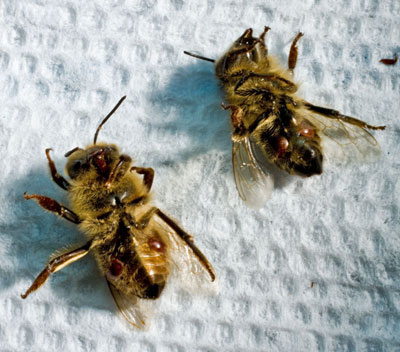|

April 9, 2013
from
FromTheTrenchesWorldReport Website

Scientists and beekeepers have been baffled by Colony Collapse
Disorder (CCD)
which is characterized by the sudden disappearance of the hive’s
worker population.
According to the USDA, symptoms of CCD include,
However, the bees are never found
elsewhere, they simply disappear and die.
Usually, the queen bee is left behind
but dies without establishing a new population.
The disorder has significantly affected bee populations since the
1970s with a sharp increase in losses since 2006. Now, as beekeepers
return to their hives to prepare for spring pollination, they are
finding that at least half of their bees are gone.
The 2013 year now marks the highest loss on record with at least 50
percent of all European honeybees in the U.S. reported lost to CCD.
The attrition rate for honeybee hives is normally around 5 to 10
percent per year. After 2006, that rate increased to about one
third. This year, it is one half.
That one-half figure is a critical point beyond which many
beekeepers think prices will be affected.
Bees are important because they pollinate most of the fruit and
vegetable supply in the United States. They also produce honey,
which is still widely consumed as a sweetener on bread and in a
variety of other products.
Just
what’s killing the bees remains a
'mystery' but beekeepers are beside themselves, often approaching
their hives to find hundreds of worker bees dying outside the hives
each day. As the bees die, farmers lose the ability to pollinate
crops, reducing yields and thereby the food supply.
Farmers are now projecting that the
decrease in the supply of fruits and vegetables will be so great
that
prices will be impacted by the
summer of this year.
A number of beekeepers blame pesticides for the loss of their bees,
specifically as class known as neonicotinoids.
Neonicotinoids are a form of
pesticide that work by blocking the nerve endings in insects,
paralyzing them so that they die slowly by starvation. Beekeepers
think their bees are being exposed to the pesticides and are dying
as a result.
Research done one dead bees confirms the pesticide is occasionally
present. This has prompted beekeepers to work together to sue the
EPA for failing to ban neonicotinoids.
Others still think the causes could be more complex, a combination
of natural and man-made factors which are contributing to the
extreme mortality rate.
What researchers have widely observed is that bees are being exposed
to a wider variety of chemicals in the environment that previously
supposed. A virtual
cocktail of pesticides and chemicals
could be contributing to their demise.
Other research has looked into the possibility of diseases such as
parasites or viruses, but no single factor has demonstrated the
lethality that beekeepers are reporting.
Although the cause remains inconclusive, the effects are now beyond
question.
The dramatic reduction in honeybee
population means
Of course, so few Americans still eat
fresh fruits and vegetables these days, the impact will probably be
mitigated somewhat by our extremely poor dietary habits.
|

